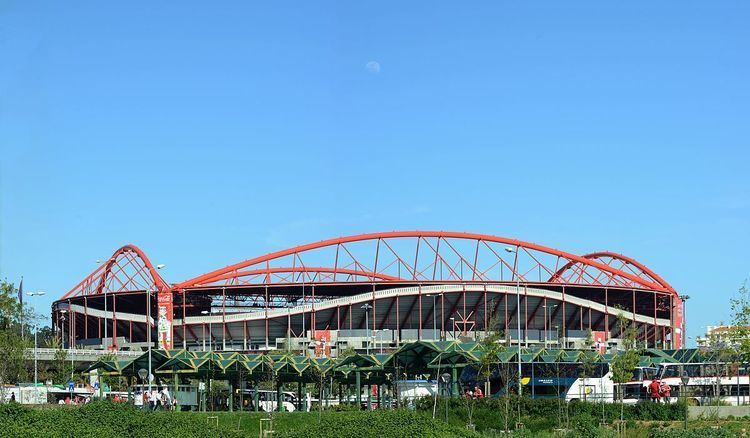Capacity 65,647 Height 43 m | Executive suites 156 Opened 25 October 2003 Team S.L. Benfica | |
 | ||
Full name Estádio do Sport Lisboa e Benfica Public transit Colégio Militar / LuzLisbon Metro Blue Line Address Av. Eusébio da Silva Ferreira, 1500-313 Lisboa, Portugal Similar Estádio José Alvalade, Estádio do Dragão, Allianz Arena, Santiago Bernabéu Stadium, Vicente Calderón Stadium Profiles | ||
The Estádio da Luz ([(ɨ)ˈʃtaðju ðɐ ˈluʃ]), officially named Estádio do Sport Lisboa e Benfica, is a multi-purpose stadium located in Lisbon, Portugal. It is used mostly for association football matches, hosting the home games of Portuguese club (and owner) S.L. Benfica.
Contents
- Naming
- Characteristics
- Benficas return to titles
- Opening game
- UEFA Euro 2004
- Portugal national football team matches
- Benfica matches in European competitions
- References
Opened on 25 October 2003 with an exhibition match between Benfica and Uruguayan club Nacional, it replaced the original Estádio da Luz which had 120,000 seats. The seating capacity was decreased to 65,647, and is currently set at 64,642. It was designed by HOK Sport Venue Event and had a construction cost of €118.7 million.
A UEFA category four stadium and one of the biggest stadiums by capacity in Europe, it hosted several matches of UEFA Euro 2004, including the final, and hosted the 2014 UEFA Champions League Final. In October 2014, it was elected as the most beautiful stadium of Europe in an online poll by French newspaper L'Équipe.
Naming
The previous stadium, which was also officially named "Estádio do Sport Lisboa e Benfica", was named in honour of the Igreja de Nossa Senhora da Luz (Church of Our Lady of the Light), and the people of Lisbon used to call it a Luz ("the Light"), so the common name for the stadium became "Estádio da Luz", which is commonly translated to English as "Stadium of Light", although inaccurately, as Luz refers not to "light" but to the original address of the stadium: Estrada da Luz. The stadium is also referred to as a Catedral (the Cathedral) or o Inferno da Luz.
Characteristics
Architect Damon Lavelle from HOK Sport Venue Event (now Populous) designed the stadium to focus on light and transparency. Its polycarbonate roof allows the rays of sunlight to penetrate the stadium, thus illuminating it. The roof, which is supported by tie-beams of four steel arches, seems to float on the underlying tribunes. The arches measure 43 metres in height and help to define the look of the stadium after having been shaped to be similar to the wavy profile of the three tiers of the stadium.
Benfica's return to titles
In the 2004–05 season, the Estádio da Luz saw Benfica's 1–0 victory over city rivals Sporting CP, before an 1–1 draw at Boavista which sealed the title for Benfica, 11 years later. Following the final whistle, thousands of fans joined the stadium to celebrate the club's 31st league title. In 2009–10, Benfica defeated Porto 1–0, an important victory to win their 32nd championship. On 20 April 2014, Benfica conquered their 33rd league title after defeating Olhanense 2–0 at home. In the following two seasons, Benfica would win two more league titles, being crowned Portuguese champions for a record 35th time. Internationally, Benfica has qualified for two UEFA Europa League finals while playing at the new stadium.
The stadium reached up to 11 million spectators on its tenth birthday. It reached the 12 million spectators mark on 17 August 2014.
Opening game
In the opening match Benfica beat Club Nacional de Football by 2–1. Benfica player Nuno Gomes scored both goals, becoming the first scorer in the history of Estádio da Luz.
UEFA Euro 2004
In the first quarter-final between England and Portugal, the English opened the scoring after only two minutes through Michael Owen. Portugal's constant attacking pressure from then on resulted in Hélder Postiga's 83rd-minute equaliser. A controversial incident came in the dying minutes when Michael Owen hit the Portuguese crossbar, resulting in a Sol Campbell header, which appeared to have given England the lead again, but his header was ruled out for what the referee Urs Meier deemed a foul on the Portuguese goalkeeper Ricardo. The sides exchanged goals in extra-time, sending the match to penalty kicks and Portugal won 6–5; Ricardo saved a penalty from Darius Vassell and then scored the winning goal.
Portugal national football team matches
The following national team matches were held in the stadium.
